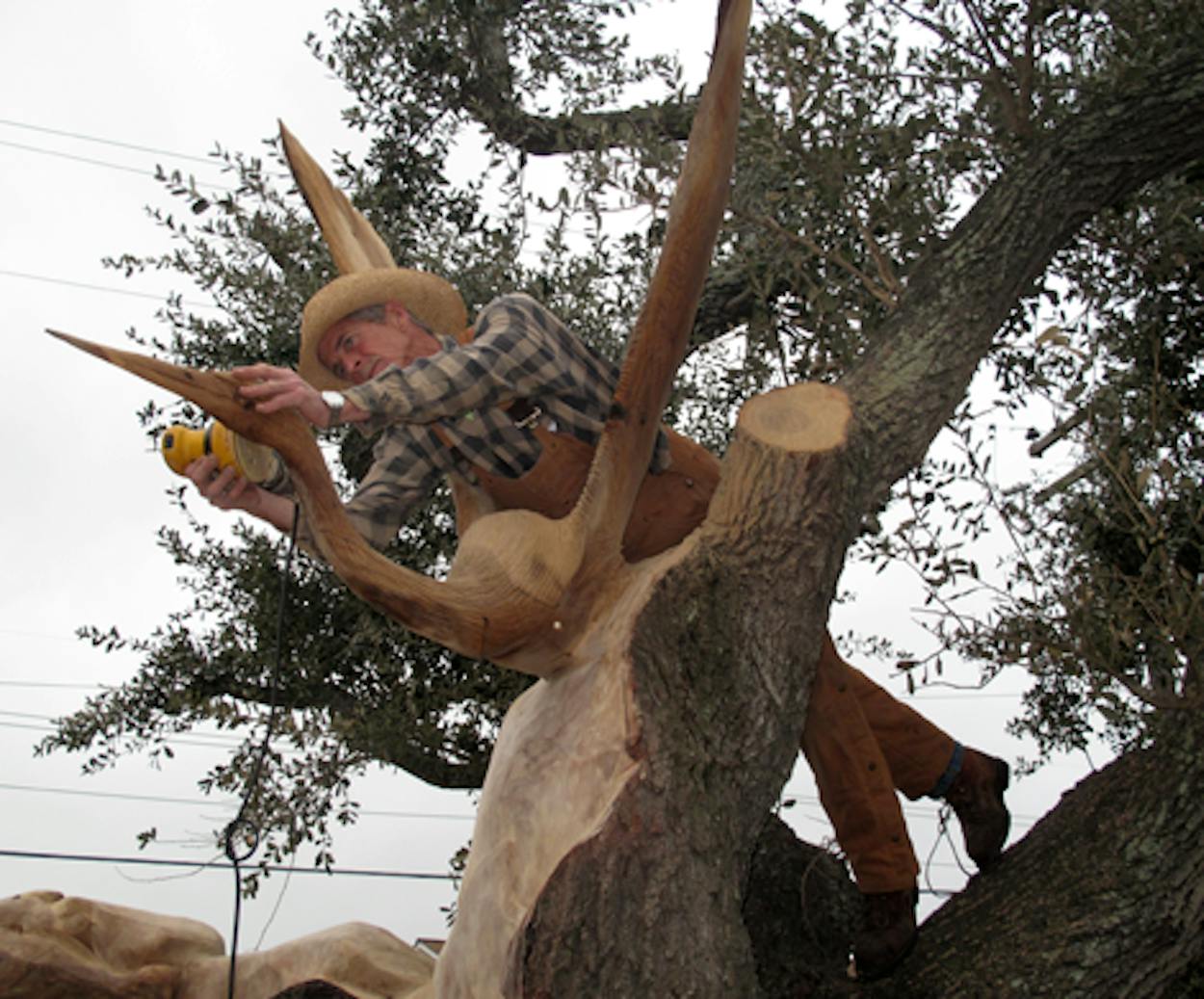The lush canopy of trees shading Galveston’s Victorian homes is gone, claimed by the saltwater storm surge of Hurricane Ike. But in the three years since the storm, the barrier island’s citizens have led a grassroots effort to preserve the memory of the trees by carving more than 35 sculptures from the remaining stumps, which stand among thousands of replanted saplings.
More than 35,000 of Galveston’s trees—many planted after the devastating 1900 hurricane—were cut down after Ike. The tree sculptures, carved from stumps still rooted in the ground, have become a whimsical yet reverent way to remember the past in the face of this loss. Three sculptors have been at work since late 2009, grinding away with chainsaws and chisels to transform the stumps into dolphins and angels and birds. Their work has become one of the island’s most popular tourist attractions.
“Everybody loves the lemons-to-lemonade story associated with the loss of those trees,” said Jimmy Phillips, one of the sculptors.
The seaside town’s grassroots art project was set in motion by Donna Leibbert, who was inspired by the sculptures carved from trees killed by Hurricane Katrina in the Biloxi, Mississippi, area. Leibbert proposed the idea to the City Council because she wanted the large, dead oak tree in her front yard to be carved, but she needed permission because it stood beyond her sidewalk in the city right-of-way. (Residents are allowed to carve what they want on private property.) So in spring 2009, Leibbert showed up at a council meeting with a tiny reproduction of one of Frank Lloyd Wright’s garden sprites to show that yard art could be visually appealing.
After months of handwringing over issues of aesthetics and liability, the city agreed to allow trees on easements to be carved, and even approved two sculptures for City Hall. In August 2009, Phillips transformed two trees into a dalmatian and a fire hydrant. They were completed in time for the first anniversary of Ike.
Carlos Antonio Rios, a retired newspaper photographer who meticulously documented the loss of the barrier island’s trees for the Galveston Island Tree Conservancy, said the sculptures have helped with the grieving process. “We were fortunate to take something that was dead and give it new life,” Rios said.
Alicia Cahill, a spokeswoman for the city, said cutting the trees was an emotional process. “That’s one of the reasons the tree sculptures are so significant and so beloved in our community,” she said.
Some of the sculptures pay homage to Galveston’s hometown heroes. Inside the Oaks subdivision, a new public housing development, Earl Jones carved a striking sculpture of the boxer Jack Johnson: his torso springing from the earth, his gloved hands triumphantly held above his head and his championship belt emblazoned with his nickname, “Galveston Giant.”
It might take a few moments to unpack the meaning of some of the other monuments—if you did not know that King Vidor, a secondary director of The Wizard of Oz, was born inside the house on the corner of Winnie and 17th streets, the statue of Toto and the Tin Man would not make much sense.
Other sculptures have personal significance. Marcy Hanson, the October 1978 Playboy Playmate of the Month, runs a bed and breakfast and rescue-bunny sanctuary on 17th and Postoffice streets and had Phillips carve her giant sycamore into an angel cradling a bunny “to honor the tree,” she explained from her breakfast nook overlooking the sculpture.
Cars wind slowly through the East End Historical District hunting for the sculptures, aided by a brochure produced by the Convention and Visitors Bureau. While several sculptures sit on city property, most of them are on private property, tucked into front yards.
The city’s mayor, Joe Jaworski, who was elected in 2010, can personally speak to the popularity of the attraction, as he has a sculpture in his own yard. “There’s not a weekend that there aren’t people driving by,” Jaworski said as a car slowly rolled by, as if on cue.
Jaworski and his wife, Rebecca, fell in love with their house on Winnie Street because of the huge oak in the front lawn. “This tree was why we bought this house,” he said.
After the storm, the tree—as with most on the island—was given almost a year to recover. But in the summer of 2009, someone from the Texas Forest Service came by to assess its health. “It was almost one of those quintessential veterinarian moments. ‘I’m sorry, she’s gone,’.” Jaworski said. “The salt just poisoned it.”
The Federal Emergency Management Agency cut down the tree, leaving the stump behind, but Rebecca Jaworski was still not sold on the idea of having a tree sculpture. One day, while looking through a historical pamphlet, she found a picture of a memorial to the victims of the 1900 storm: a Greek column, broken at the top to symbolize a life cut short. An oak column now stands in the Jaworskis’s yard, a memorial to the trees lost 108 years after the 1900 storm.
The Galveston Island Tree Conservancy wants to replace the trees—without their shade, utility bills are higher—and, with the help of donations, has already replanted more than 8,000 in the city, using historical photographs as a guide.
Jaworski has replaced several trees in his own front yard. “Maybe someone in one hundred years is going to buy this house because of those trees,” he said, pointing to a pair of live oak saplings.








